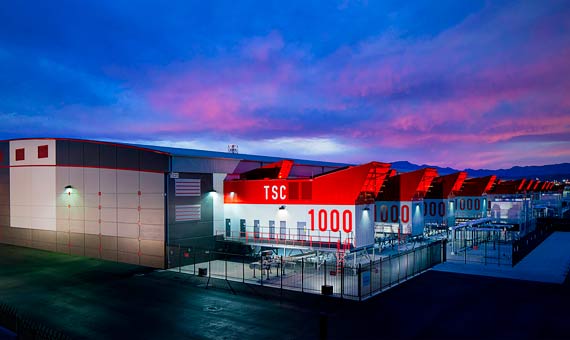A data center is a facility that holds all the necessary hardware to store, manage and deal with hundreds of thousands of bits of all kinds of company data, corporate email accounts and their respective servers, financial reports and customer sheets, pictures or videos we upload to Facebook, and all of the different software alternatives which a big company uses as platform.

As logic dictates, the bigger the company is, the bigger the volume of data to manage, although we have to consider other aspects such as the core of each company (we can’t compare a technological company to one in the service sector), the data management philosophy (whether they opted to move their data infrastructure to the cloud or not), or if they have an international presence, etc.
In any case, the globalization of the economy, the expansion of multinational companies around the world and the “always on” trend that propelled Internet democratization, have meant an exponential rise in data (as an illustration, 4.1 million searches are performed on Google every minute, according to Intel figures), that triggered the creation of giant data centers to deal efficiently with the enormous quantity of information that big companies get every day.
Obviously, data centers must follow strict security and maintenance protocols, as they are responsible for much of the daily operations of hundreds of companies around the world. A SAP data center must have enough energy generators to pull 29 MW of power (enough to supply a city with a population of around 50,000) and the facilities must keep the temperature under 26 degrees Celsius to keep the hardware from overheating. Not to mention the responsibility for security personnel, security cameras and other protocols to avoid data theft or data loss (for instance, with regard to the previously mentioned SAP example, more than ten thousand smoke detectors are required in each data center).
Which are the biggest data centers in the world? Here are some of the most outstanding.
Range Technology Development (Langfang, China)
It is Asia’s biggest data center and takes up a surface of 610,000 square meters (in comparison, the Pentagon is 600,000 square meters). Built in collaboration with IBM, it is one of the most advanced cloud based data centers in the world, which means the data is stored physically in the complex as well as replicated and secured in the cloud (and, as such, readily accessible from any other point in the world).
Microsoft Chicago (Northlake, Illinois)
Most of you probably use Skype, Office, Outlook or Xbox Live in your daily routines. All of these services belong to Microsoft and have millions of active users distributed all around the world. One of the biggest Microsoft data centers supporting a good part of their active user base is located near Chicago. It takes up more than 60,000 square meters and is powered entirely by wind generators. It houses more than 220,000 servers). More than 500 million US dollars were invested in its construction (source: Microsoft).
Super NAP (Las Vegas, Nevada)
Located in Las Vegas, this over 110,000 square meter complex holds 9 data centers. SuperNAP’s differentiator is its dependence to renewable energy, thanks to corporate social responsibility initiatives of big companies. In fact, Swift, the company behind these facilities, claims to be “the best regarded by their customers” in the data center space.

Not to be confused with SuperNAP data center in Tahoe-Reno, also in Nevada and also a Swift property. This new installation is in its early phases of development. It is also a very ambitious project aimed to hold seven data centers in an area of 603,000 square meters.
Biggest unknowns
Although big companies take a proud stand sharing huge data center figures, there are other companies that take a much more discreet approach and keep most of this information private. Companies such as Google or Facebook (owner of both Instagram and WhatsApp) in which their main line of business revolves around data storage and management, have never shared specific figures about their data centers. Just very specific facts related to security, efficiency and environment-friendly features. This keeps a very low profile on infrastructure and lowers possibilities of attacks or hacking attempts.
Even so, taking into account the millions of requests per minute (just think about the sheer quantity of pictures, comments and conversations that are produced in any of these social networks), it shouldn’t be a surprise if their data centers are even bigger than some of the listed above in this article.
What about Europe?
The biggest data center in Europe is located in Newport (Wales) and belongs to NGD (New Generation Data). It has an area of 70,000 square meters and is completely powered by renewable energy.
Telefónica has its own big Data Center in Alcalá de Henares, in the Madrid area. Although well short of the figures in terms of area of the North American data centers, it is the first European facility to ever get a TIER IV Gold certification, the technical term that distinguishes the most sophisticated data centers in the industry. A mark so high that, by definition, a TIER IV Gold data center can’t be offline for more than 26 minutes each year. According to Telefónica, their customers are mostly IBEX 35 companies and government agencies.
Telefónica’s data center comprises an area of about 65,700 square meters and needs a power supply equivalent of a city with a population of 40,000.
Also with a TIER IV Gold certificate, BBVA’s Tres Cantos II data center, located in Tres Cantos Madrid. With over 20,000 square meters, their main focus is security. A very logical approach, taking into account that this is a financial services multinational. It has multiple layers of redundancy, which guarantees uninterrupted service and shields itself from possible attacks.
César Muela
(Hipertextual) for OpenMind
Comments on this publication